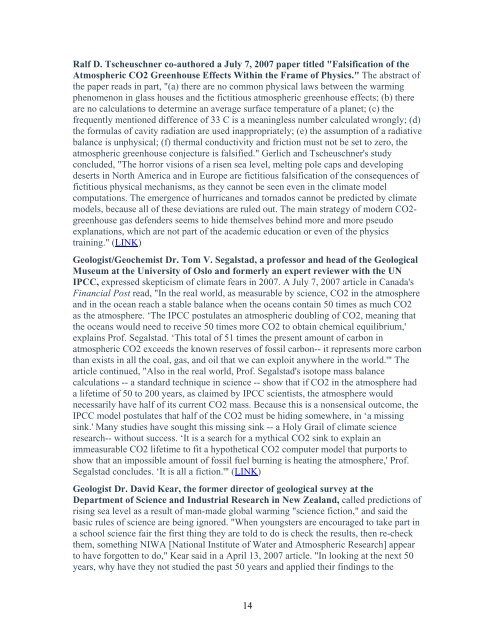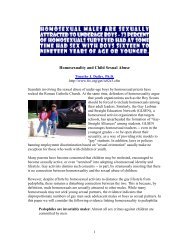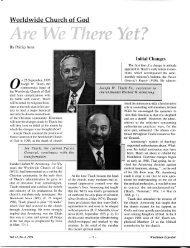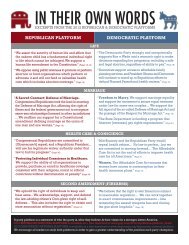U.S. Senate Report: Over 400 Prominent Scientists Disputed ... - NJIAT
U.S. Senate Report: Over 400 Prominent Scientists Disputed ... - NJIAT
U.S. Senate Report: Over 400 Prominent Scientists Disputed ... - NJIAT
You also want an ePaper? Increase the reach of your titles
YUMPU automatically turns print PDFs into web optimized ePapers that Google loves.
Ralf D. Tscheuschner co-authored a July 7, 2007 paper titled "Falsification of the<br />
Atmospheric CO2 Greenhouse Effects Within the Frame of Physics." The abstract of<br />
the paper reads in part, "(a) there are no common physical laws between the warming<br />
phenomenon in glass houses and the fictitious atmospheric greenhouse effects; (b) there<br />
are no calculations to determine an average surface temperature of a planet; (c) the<br />
frequently mentioned difference of 33 C is a meaningless number calculated wrongly; (d)<br />
the formulas of cavity radiation are used inappropriately; (e) the assumption of a radiative<br />
balance is unphysical; (f) thermal conductivity and friction must not be set to zero, the<br />
atmospheric greenhouse conjecture is falsified." Gerlich and Tscheuschner's study<br />
concluded, "The horror visions of a risen sea level, melting pole caps and developing<br />
deserts in North America and in Europe are fictitious falsification of the consequences of<br />
fictitious physical mechanisms, as they cannot be seen even in the climate model<br />
computations. The emergence of hurricanes and tornados cannot be predicted by climate<br />
models, because all of these deviations are ruled out. The main strategy of modern CO2-<br />
greenhouse gas defenders seems to hide themselves behind more and more pseudo<br />
explanations, which are not part of the academic education or even of the physics<br />
training." (LINK)<br />
Geologist/Geochemist Dr. Tom V. Segalstad, a professor and head of the Geological<br />
Museum at the University of Oslo and formerly an expert reviewer with the UN<br />
IPCC, expressed skepticism of climate fears in 2007. A July 7, 2007 article in Canada's<br />
Financial Post read, "In the real world, as measurable by science, CO2 in the atmosphere<br />
and in the ocean reach a stable balance when the oceans contain 50 times as much CO2<br />
as the atmosphere. ‘The IPCC postulates an atmospheric doubling of CO2, meaning that<br />
the oceans would need to receive 50 times more CO2 to obtain chemical equilibrium,'<br />
explains Prof. Segalstad. ‘This total of 51 times the present amount of carbon in<br />
atmospheric CO2 exceeds the known reserves of fossil carbon-- it represents more carbon<br />
than exists in all the coal, gas, and oil that we can exploit anywhere in the world.'" The<br />
article continued, "Also in the real world, Prof. Segalstad's isotope mass balance<br />
calculations -- a standard technique in science -- show that if CO2 in the atmosphere had<br />
a lifetime of 50 to 200 years, as claimed by IPCC scientists, the atmosphere would<br />
necessarily have half of its current CO2 mass. Because this is a nonsensical outcome, the<br />
IPCC model postulates that half of the CO2 must be hiding somewhere, in ‘a missing<br />
sink.' Many studies have sought this missing sink -- a Holy Grail of climate science<br />
research-- without success. ‘It is a search for a mythical CO2 sink to explain an<br />
immeasurable CO2 lifetime to fit a hypothetical CO2 computer model that purports to<br />
show that an impossible amount of fossil fuel burning is heating the atmosphere,' Prof.<br />
Segalstad concludes. ‘It is all a fiction.'" (LINK)<br />
Geologist Dr. David Kear, the former director of geological survey at the<br />
Department of Science and Industrial Research in New Zealand, called predictions of<br />
rising sea level as a result of man-made global warming "science fiction," and said the<br />
basic rules of science are being ignored. "When youngsters are encouraged to take part in<br />
a school science fair the first thing they are told to do is check the results, then re-check<br />
them, something NIWA [National Institute of Water and Atmospheric Research] appear<br />
to have forgotten to do," Kear said in a April 13, 2007 article. "In looking at the next 50<br />
years, why have they not studied the past 50 years and applied their findings to the<br />
14








